From the heart of Accra in the Southern part of the country to Damongo, in Ghana’s Savanna Region, young climate activists last Friday, September 27, 2019, abandoned their daily routines and joined the rest of the world to demand immediate action on climate change.
In a massive protest that could be described as ‘Epic’, activists took to the streets, asking Ghana’s government to take urgent steps to tackle the climate crisis and prevent recent and future environmental catastrophes.
These actions have been inspired by Greta Thunberg, a 16-year-old Swedish climate activist who sprung to fame for her activism when, at age 15, she began spending her school days outside the Swedish Parliament to call for stronger action on global warming by holding up a sign saying (in Swedish) “School strike for climate”. Soon, other students engaged in similar protests in their own communities. Together they organized a school climate strike movement under the name Fridays for Future. The Global Climate Strike also formed part United Nations (UN) Climate week commemoration.
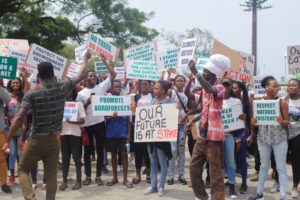
The recent strike which was organized by A Rocha Ghana (ARG) in collaboration with other Civil Society Organisations (CSOs) and student groups, saw not less than 1000 protesters (mainly students) gather in four different regions—Greater Accra, Ashanti, Eastern and Savanna regions.
Supporting partners include; Tropenbos Ghana, Youth Alliance for Green Ghana, Kasa Initiative Ghana, Forest Watch Ghana, Ghana Youth Environmental Movement (GYEM).
Media houses who aided the success of the strike were; Joy News, JoyFM, TV3, Starr FM, Fox FM, The Chronicle, Ghana News Agency and Ultimate FM.
Accra Strike
In the capital Accra, about 200 activists thundered through some principal streets.
Together with members of the general public, CSOs and students poured onto the streets amidst chanting and singing; demanding government to adopt policies and take steps that would secure Ghana’s natural environment. The demonstrators, wore various paraphernalia and held placards with inscriptions such as ‘Raise Your Voice; Not Sea Levels,’ ‘Protect The Environment, Secure The Future,’ ‘It Is Not An Investment If It Destroys The Environment,’ among others.
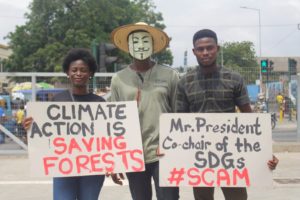
The protesters began the strike at the Obra park around the Kwame Nkrumah Circle and ended at the Accra Metropolitan Assembly (AMA), in Accra. Protesters on their walk took time to educate onlookers on the reasons for their walk. To the surprise of many, a large faction of the Ghanaian populace where at a loss—they either had never heard of the term Climate Change or did not understand what it meant.
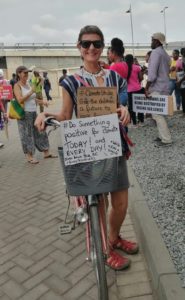 Addressing the media, Deputy Director for ARG, Mr. Daryl Bosu mentioned several areas through which government could help mitigate the ills of climate change. Amongst them were; the need for Ghana’s public transport system to improve. This he said will reduce the number of cars that ply our streets which will in turn reduce the quantity of carbon emission.
Addressing the media, Deputy Director for ARG, Mr. Daryl Bosu mentioned several areas through which government could help mitigate the ills of climate change. Amongst them were; the need for Ghana’s public transport system to improve. This he said will reduce the number of cars that ply our streets which will in turn reduce the quantity of carbon emission.
“If government is able to improve our public transport systems and make it more open and accessible to all, we can park our cars at home and ride,” he said.
Mr. Bosu also spoke of the need to have good health systems that would have Ghanaians adapt to Climate change. He further highlighted the need for investments that would enhance Ghana’s natural solutions and not destroy them.
He said, “activities that destroy the environment and forest reserves, we need to stop them. We are doing well on trying to stop galamsey but more needs to be done because these activities are destroying the natural solutions that would have helped us build adaptation and resilience.”
Damongo
Schools’ Environmental Clubs within Savannah Region had observed the climate strike with a number of activities.
As part of the Global Strike for climate, students presented petitions to the overlord of Gonjaland and Savannah Regional Coordinating Council at separate locations to demand actions to mitigate Climate Change.
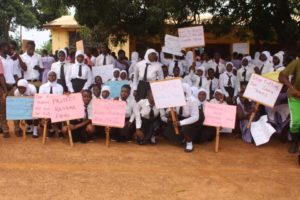
The need of every ecological area varies and in the Savannah region they are asking for proactive measures to halt ongoing illegal logging (especially of rosewood and shea trees) and unsustainable charcoal production.
The Climate Strike dubbed; “Fridays for Future” float started at the Damongo Nurses Training College entrance, through the principal streets to the Damongo lorry station. The teaming youth at the lorry park delivered a message to the drivers, passengers and the community members alike.
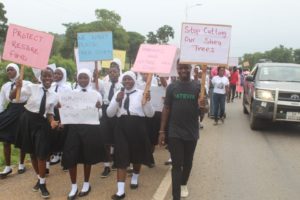
The strikers then connected to the Jakpa Palace where a petition was read and presented to Yagbonwura Tuntumba Boresa Sulemana I.
Receiving the petition, the King thanked the students and other environmental activists present and promised to distribute copies of the petition to all the paramouncies within the Gonja Kingdom for immediate action to be taken to improve the environment.
Another petition was presented to the Savannah Regional Minister, Alhaji Abu Forgor. Receiving the petition on behalf of the minister, the Deputy Regional Coordinating Director of the Savannah Regional Coordinating Council (SRCC) assured the public that the SRCC will work closely with the district assemblies to help improve issues of climate and the environment in general.
Find full copy of the petition here
Kumasi
Ghana’s garden city—was not left out in the strike even as they vowed to keep the Ashanti as ‘green’ as it was meant to be. Strikers in the region did not just throng to the streets to make their demands known, they further took time to mark the day with a tree planting exercise. The strike aimed at planting 1000 trees on that day, fell short following a heavy downpour. Unperturbed by the development, the protesters promised to continue the exercise when the weather becomes fairer.
After receiving a petition from protesters, Mayor of Kumasi, Osei Assibey Antwi also joined the strike. He also led the protesters in the tree planting exercise.
Same petition was also presented to the Regional Coordinating Council in Kumasi.

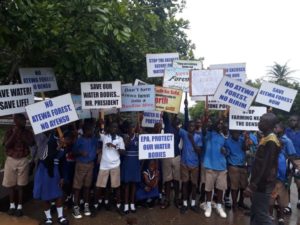
Kyebi
The March in the Eastern Region was hosted in Kyebi where school children where pooled from various schools to mark the day. Students in the region petitioned the Environmental Protection Agency (EPA) to protect their forests and water bodies. They further appealed to government to rescind its decision to mine bauxite in the Atewa forest.
Realities Cannot Be Ignored
While catastrophes are getting harder to predict, disasters becoming more frequent and expensive; yet still, many including renowned world leaders have labelled the phenomenon of climate change as a hoax. In America for instant, President Donald Trump wants to drags out his country out of the Paris Agreement—a pact which aims at limiting the increase in global average temperatures to “well below 2°C above pre-industrial levels.” In a similar baneful stride, Australia’s conservative government is running away from climate commitments. This, thankfully is not the situation on Ghanaian soil.
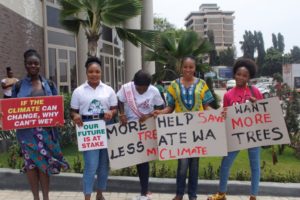
Though some human activities we indulge in seem not reflect our stand as a country, Ghana’s government acknowledges climate change as a challenge that needs expedient attention.
Speaking at the just ended United Nations (UN) General Assembly held in New York last month, Ghana’s President Nana Addo Dankwa Akufo-Addo was emphatic on the realities of climate change which he said, has become impossible to ignore. He therefore made a clarion call on world leaders to commit practical steps to countering the degradation of the earth.
“Now that the scientists have spoken on the realities of climate change, I believe it is time to direct our energies to what we can and should do to counteract the danger, and stop unnecessary arguments.
“Nature has been brutal this year in demonstrating to us that our climate is changing, and we are probably pushing our world to destruction. The devastation wreaked by Cyclone Idai, Hurricane Dorian, the extreme summer temperatures across Europe, surely provide the evidence, if some were still needed, that it is time to take action to bring back our world from the precipice,” he had stated.
By Grace Ablewor Sogbey

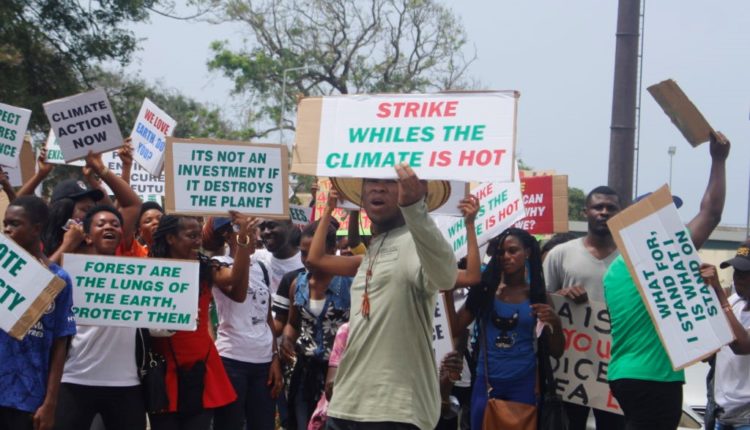
Comments are closed.